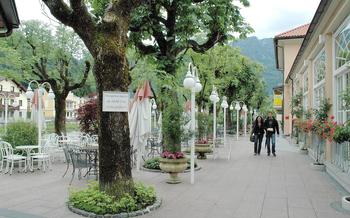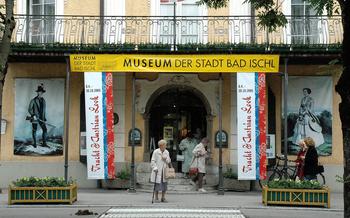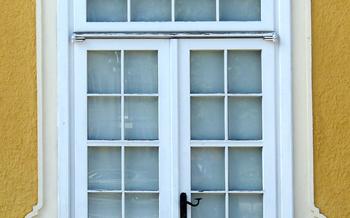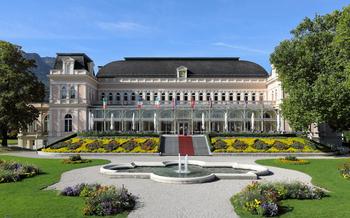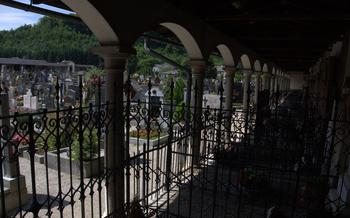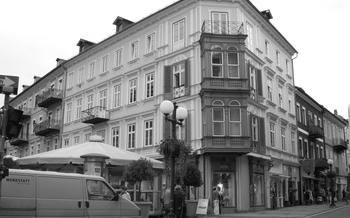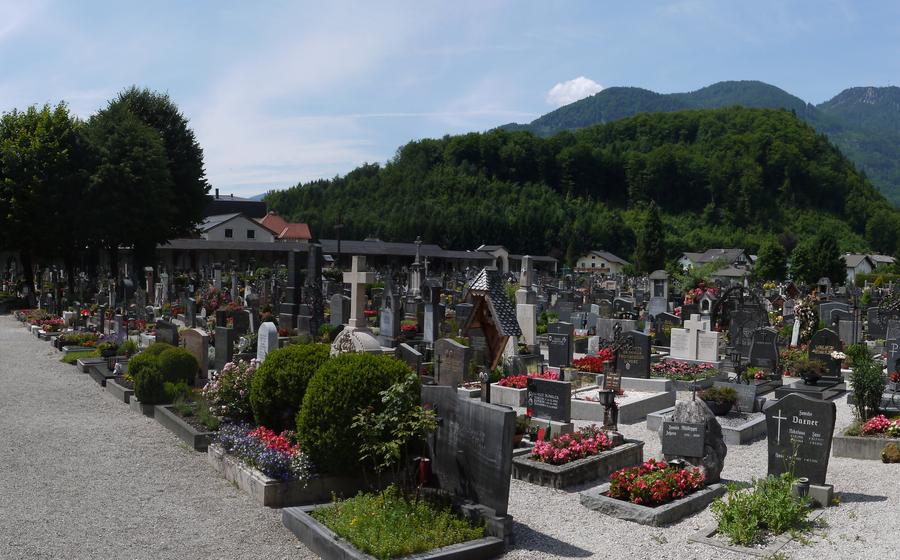
Naturhistorisches Museum Gosau
- Bad Ischl: A Town Steeped in History and Natural Beauty
- Naturhistorisches Museum Gosau: A Treasure Trove of Natural History
- Exploring the Museum's Fossil Collection
- Unraveling the Mysteries of the Gosau Formation
- Interactive Exhibits for Hands-on Learning
- The Museum's Role in Scientific Research
- Exploring Bad Ischl's Imperial Legacy
- Indulging in Bad Ischl's Culinary Delights
- Exploring the Salzkammergut Region
- Attending the Lehár Festival
- Tips for Photography Enthusiasts
- Insider Tip: Hidden Gem of Bad Ischl
Bad Ischl: A Town Steeped in History and Natural Beauty
Nestled amidst the picturesque landscapes of the Salzkammergut region, Bad Ischl is a town that seamlessly blends imperial grandeur with captivating natural beauty. Its historical significance stems from its imperial past, having served as the beloved summer residence of Emperor Franz Joseph and Empress Elisabeth of Austria. The town's imperial legacy is still palpable in its elegant architecture, charming parks, and cultural attractions.
Surrounded by the majestic peaks of the Dachstein massif and glistening lakes, Bad Ischl offers a breathtaking natural setting. Visitors can embark on scenic hikes or bike rides through the surrounding mountains, or simply relax and soak in the tranquility of the idyllic lakeside promenades. The town's cultural scene is equally vibrant, with highlights including the annual Lehár Festival, which celebrates the works of the renowned operetta composer Franz Lehár, who had a strong connection to Bad Ischl.
For those seeking a deeper understanding of the region's history and culture, the town's tourist information centers provide valuable insights and assistance. Transportation to and from Bad Ischl is convenient, with regular train and bus connections to major cities. Accommodation options range from charming guesthouses to elegant hotels, catering to every traveler's preference.
Naturhistorisches Museum Gosau: A Treasure Trove of Natural History
Museum Overview The Naturhistorisches Museum Gosau is a natural history museum located in the town of Gosau, Austria, in the heart of the Salzkammergut region. Established in 1982, the museum is dedicated to preserving and showcasing the region's rich natural history, with a particular focus on the fossils of the Gosau Formation.
Fossil Collection The museum houses a renowned collection of fossils, including dinosaur bones, marine creatures, and plant fossils. The highlight of the collection is the Gosaurosaurus, a dinosaur that lived in the region during the Late Cretaceous period. Other notable specimens include ammonites, belemnites, and other marine fossils that provide valuable insights into the ancient ecosystems of the Gosau Formation.
Interactive Exhibits The museum features engaging and educational exhibits that bring natural history to life. Visitors can interact with life-size dinosaur models, handle real fossils at fossil touch tables, and immerse themselves in virtual reality experiences that transport them back in time to witness prehistoric life. The museum also offers a variety of educational programs and workshops for visitors of all ages.
Research and Conservation The Naturhistorisches Museum Gosau is actively involved in scientific research and conservation efforts. The museum's paleontologists conduct research on the fossils of the Gosau Formation, contributing to our understanding of ancient life and environments. The museum also collaborates with universities and research institutions on joint research projects and engages in citizen science initiatives, allowing visitors to participate in ongoing research.
Exploring the Museum's Fossil Collection
The Naturhistorisches Museum Gosau houses an impressive collection of fossils that provide a glimpse into the region's rich geological past. Among the highlights is the Gosaurosaurus, a remarkable dinosaur fossil discovered in the nearby Gosau Formation. This well-preserved skeleton offers valuable insights into the life and behavior of these ancient creatures.
The museum's marine fossil collection is equally impressive, featuring a diverse array of ammonites, belemnites, and other marine creatures that once inhabited the region's ancient seas. These fossils provide important clues about the region's past climate and environment.
Visitors can also get a behind-the-scenes look at how fossils are prepared and preserved. The museum's dedicated preparation lab allows visitors to observe the meticulous process of cleaning, repairing, and cataloging fossils before they are put on display.
For those seeking a deeper understanding of the fossils, the museum offers a range of educational resources. Fossil-related books, brochures, and interactive activities cater to visitors of all ages, making the museum a valuable learning resource for both children and adults.
Unraveling the Mysteries of the Gosau Formation
The Gosau Formation holds immense geological significance, serving as a window into the region's ancient past. This sedimentary rock formation dates back to the Late Cretaceous period, a time when the area was submerged beneath a vast ocean. Over millions of years, layers of sediment accumulated on the seafloor, forming the foundation of what would become the Gosau Formation.
The depositional environment of the Gosau Formation was complex and dynamic. The area experienced alternating periods of marine and terrestrial deposition, resulting in a diverse sequence of rock layers. During marine periods, sediment from rivers and streams was carried into the ocean and deposited on the seafloor. During terrestrial periods, the area was exposed to land, allowing for the formation of coal seams and freshwater deposits.
The fossil record of the Gosau Formation is exceptionally rich and diverse, providing valuable insights into the ancient ecosystems that thrived in this region. The fossils include a variety of marine creatures, such as ammonites, belemnites, and fish, as well as terrestrial animals, such as dinosaurs and mammals. These fossils offer a glimpse into the evolutionary history of the region and help scientists reconstruct the ancient environments that existed here millions of years ago.
Ongoing research on the Gosau Formation continues to shed light on its geological and paleontological significance. Scientists are actively studying the formation's rock layers, fossils, and depositional environments to gain a deeper understanding of the region's geological history. This research contributes to our knowledge of ancient ecosystems, climate change, and the evolution of life on Earth.
Interactive Exhibits for Hands-on Learning
The Naturhistorisches Museum Gosau goes beyond traditional displays to offer captivating interactive experiences that bring the world of fossils and natural history to life. Visitors can engage with life-size models of dinosaurs, allowing them to get up close and personal with these prehistoric giants. Fossil touch tables provide a hands-on opportunity to handle real fossils and learn about their significance.
Virtual Reality Experiences:
Immerse yourself in the ancient world through virtual reality experiences that transport you back in time. These cutting-edge simulations offer a unique perspective on the lives and habitats of extinct creatures, making learning about natural history an unforgettable adventure.
Children's Activities:
The museum caters to younger visitors with a range of playful and educational activities. Interactive games, puzzles, and hands-on exhibits spark curiosity and encourage children to explore the wonders of natural history. Whether it's building a dinosaur skeleton or creating a fossil imprint, kids will have a blast while learning.
The Museum's Role in Scientific Research
The Naturhistorisches Museum Gosau is not merely a repository of fossils; it is also an active center of scientific research. Paleontologists at the museum are engaged in a variety of research projects, including the study of dinosaur footprints, the evolution of marine reptiles, and the paleoecology of the Gosau Formation. The museum's extensive fossil collection provides a valuable resource for these research endeavors.
In addition to its own research activities, the museum collaborates with universities and research institutions around the world. These partnerships facilitate joint research projects, the exchange of ideas and expertise, and the training of young scientists. The museum also offers opportunities for citizen scientists to participate in research projects, such as fossil identification and data collection.
The museum's research findings are disseminated through scientific publications, conferences, and presentations. These publications contribute to the advancement of paleontological knowledge and help to raise awareness of the importance of fossil preservation and conservation.
Exploring Bad Ischl's Imperial Legacy
Bad Ischl's imperial legacy is deeply intertwined with the Habsburg dynasty, which ruled Austria for over 600 years. The town was a favored summer retreat for the imperial family, and the presence of the Habsburgs left an indelible mark on Bad Ischl's architecture, culture, and traditions.
A must-visit destination for history buffs is the Imperial Villa, the former summer residence of Emperor Franz Joseph and Empress Elisabeth (Sisi). This magnificent palace, built in the neoclassical style, offers a glimpse into the lives of the imperial family. Visitors can tour the villa's opulent rooms, which are adorned with exquisite furniture, artwork, and personal belongings of the Habsburgs.
Adjacent to the Imperial Villa is the Kaiservilla Park, a sprawling green space that invites visitors to stroll along its manicured paths and admire its beautiful gardens. The park offers stunning views of the surrounding mountains and is a popular spot for picnics and relaxation.
To delve deeper into Bad Ischl's imperial history, visit the Museum of Local History. This fascinating museum houses a collection of artifacts, documents, and photographs that tell the story of Bad Ischl's development from a small village to a renowned imperial summer resort.
Finally, don't miss the Imperial Trail, a walking path that connects significant imperial sites in Bad Ischl. Follow the trail to discover landmarks such as the Trinkhalle, where the Habsburgs took their mineral water, and the Kurpark, a beautiful park that was frequented by the imperial family.
Indulging in Bad Ischl's Culinary Delights
Bad Ischl is not just a town of imperial history and natural beauty; it is also a culinary paradise. The town's café culture is vibrant, with traditional coffee houses serving delectable pastries like the Ischler Törtchen, a chocolate-coated sponge cake with apricot jam filling.
For a taste of regional cuisine, try Salzburger Nockerl, a fluffy soufflé-like dessert, or Kasnocken, a hearty dish made with cheese dumplings and bacon. The weekly farmers' market is a great place to pick up fresh produce and local delicacies, including cheeses, sausages, and jams.
To immerse yourself further in the culinary traditions of Bad Ischl, consider taking a cooking class. Learn how to prepare traditional Austrian dishes such as Wiener Schnitzel, Tafelspitz (boiled beef), or Apfelstrudel (apple strudel). These classes are a great way to not only learn about Austrian cuisine but also to savor the flavors of the region.
Exploring the Salzkammergut Region
Beyond Bad Ischl's imperial charm lies the breathtaking Salzkammergut region, a haven of natural wonders and outdoor adventures. Discover the region's pristine lakes, such as the emerald-green Lake Hallstatt and the picturesque Lake Wolfgangsee, which offer opportunities for swimming, boating, and fishing. Lace up your hiking boots and embark on the region's extensive network of hiking trails, which wind through lush forests, past cascading waterfalls, and up to panoramic mountain viewpoints. For a more leisurely experience, hop on a bike and cycle along the scenic bike paths that crisscross the region, offering breathtaking views of the Alpine landscape. Don't miss the charming Alpine villages that dot the Salzkammergut, each with its unique character and history. Hallstatt, with its iconic lakeside setting and ancient salt mines, is a must-visit, as is St. Wolfgang, with its picturesque harbor and historic pilgrimage church.
Attending the Lehár Festival
Bad Ischl's musical heritage is deeply intertwined with the operetta composer Franz Lehár, who spent his summers in the town and composed some of his most famous works here. The Lehár Festival, held annually in July and August, celebrates this legacy with a vibrant program of operetta performances, concerts, workshops, and exhibitions.
Attending the Lehár Festival is a unique opportunity to experience the town's musical heritage firsthand and immerse yourself in the world of operetta. Performances take place in historic venues associated with Lehár, such as the Lehárvilla, where he composed many of his masterpieces. The festival atmosphere is electric, with music filling the streets and a palpable sense of excitement in the air.
Whether you're a seasoned operetta enthusiast or simply looking for a memorable cultural experience, the Lehár Festival is a must-attend event. Immerse yourself in the music, soak up the atmosphere, and discover the charm of Bad Ischl through the lens of its musical heritage.
Tips for Photography Enthusiasts
Bad Ischl and the surrounding Salzkammergut region offer a wealth of photographic opportunities, from the museum's exhibits to the town's imperial architecture and the region's stunning natural landscapes.
To capture the best shots of the museum's exhibits, use a tripod to steady your camera and avoid blurry images. Experiment with different angles and lighting to create unique and eye-catching compositions.
When photographing Bad Ischl's landscapes, take advantage of the town's many viewpoints to capture panoramic vistas of the town and the surrounding mountains. Don't forget to capture the town's charming streets and buildings, which are full of architectural details and historical charm.
The Salzkammergut region is a photographer's paradise, with its picturesque lakes, rolling hills, and majestic mountains. Explore the region's many hiking trails to find hidden viewpoints and secluded spots that offer stunning photo opportunities.
If you're interested in improving your photography skills, consider attending one of the photography workshops or courses offered in Bad Ischl. These workshops are led by experienced photographers who can provide you with valuable tips and techniques for capturing the best shots of your travels.
Insider Tip: Hidden Gem of Bad Ischl
For those seeking a hidden gem off the beaten path, Bad Ischl holds a few secrets worth discovering. One such treasure is a secluded viewpoint that offers breathtaking panoramic views of the town and its stunning Alpine surroundings. Embark on a leisurely hike through the picturesque landscapes, following a winding trail that leads to this hidden vantage point. As you reach the summit, be rewarded with an unforgettable vista that will leave you in awe of Bad Ischl's natural beauty.
Another insider tip is to visit a local's favorite café, tucked away in a charming side street. This hidden gem is known for its delectable traditional Austrian pastries and aromatic coffee. Indulge in the mouthwatering flavors of freshly baked cakes and pastries while immersing yourself in the warm and welcoming atmosphere of this local haunt.
For those seeking an adventurous hiking experience, venture off the beaten track and explore a lesser-known trail that leads to a secluded Alpine lake. This hidden gem offers a tranquil escape from the hustle and bustle of everyday life. Surrounded by towering peaks and lush forests, this pristine lake invites you to immerse yourself in the serenity of nature.
And finally, when it comes to souvenirs, consider bringing back a unique memento that truly captures the essence of Bad Ischl. Look for handcrafted items made by local artisans, such as intricate wooden carvings or colorful pottery. Alternatively, indulge in a taste of the region by purchasing local delicacies like artisanal jams, honey, or schnapps. These unique souvenirs will serve as lasting reminders of your time spent in this charming Austrian town.
